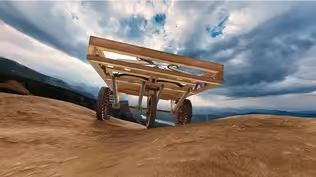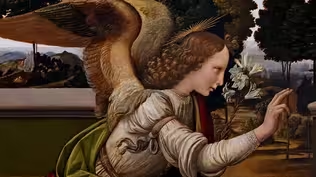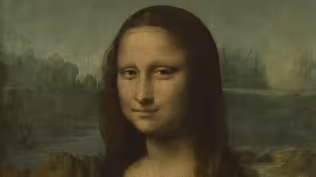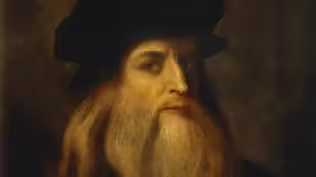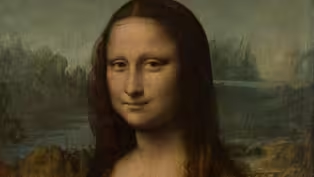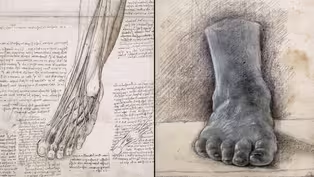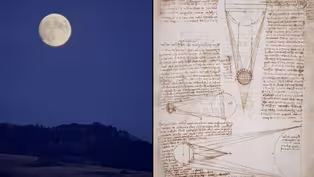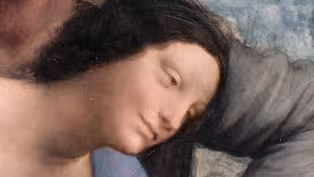
Michelangelo, Leonardo da Vinci and The Battle of Anghiari
Clip: 11/19/2024 | 10m 9sVideo has Closed Captions
Leonardo da Vinci’s The Battle of Anghiari commission pits him against his rival, Michelangelo.
In October 1503, Leonardo da Vinci begins work on a monumental mural, The Battle of Anghiari. But the commission also put him in close proximity to his rival, Michelangelo, who was hired to paint a second mural in the council hall. Just as the central scene of Leonardo’s mural started to take shape, he stopped – abandoning yet another commission. It’s unlikely Michelangelo ever began his mural.
Problems playing video? | Closed Captioning Feedback
Problems playing video? | Closed Captioning Feedback
Corporate funding for LEONARDO da VINCI was provided by Bank of America. Major funding was provided by the Corporation for Public Broadcasting, and by The Better Angels Society and by...

Michelangelo, Leonardo da Vinci and The Battle of Anghiari
Clip: 11/19/2024 | 10m 9sVideo has Closed Captions
In October 1503, Leonardo da Vinci begins work on a monumental mural, The Battle of Anghiari. But the commission also put him in close proximity to his rival, Michelangelo, who was hired to paint a second mural in the council hall. Just as the central scene of Leonardo’s mural started to take shape, he stopped – abandoning yet another commission. It’s unlikely Michelangelo ever began his mural.
Problems playing video? | Closed Captioning Feedback
How to Watch Leonardo da Vinci
Leonardo da Vinci is available to stream on pbs.org and the free PBS App, available on iPhone, Apple TV, Android TV, Android smartphones, Amazon Fire TV, Amazon Fire Tablet, Roku, Samsung Smart TV, and Vizio.
Buy Now
Providing Support for PBS.org
Learn Moreabout PBS online sponsorshipThat fall, the Republic hired him to paint a monumental fresco to adorn one wall in the city's enormous grand council hall, where members of the ruling Signoria met.
It would be 3 times larger than "The Last Supper," commemorating Florence's triumph over Milan on the plain of Anghiari more than 60 years earlier.
Nicholl: The Battle of Anghiari was a battle just within living memory in which a heavily outnumbered Florentine troop defeated the Milanese army.
And Leonardo was presumably expected to produce a stirring battle scene with ranks of horsemen and bold captains.
Narrator: He was given a studio in a suite of rooms reserved for papal visits at the Church of Santa Maria Novella.
While laborers erected scaffolding and covered his windows to diffuse the light so he could begin his cartoon, Leonardo jotted down compositional ideas, created models of soldiers in wax, and filled a notebook with sketches of horses in various poses.
Now, he also gives us a description of how to do a battle.
And he describes everything that's going on in the battle.
He then says, "You've got to calculate-- the dust in the air and how it's brighter above than below."
Man as Leonardo: First you must represent the smoke of artillery mingling in the air with the dust tossed up by the movement of horses and combatants.
♪ The dust, being a thing of earth, has weight; It is the finest part that rises highest; so that part will be least visible and will seem almost the same color as the air.
♪ Kemp: This is extraordinary description of how to do a battle, and I've likened it to a visual layout of what you do in a film.
And even a film would find it hard to capture all that.
Man as Leonardo: Some might be shown disarmed and beaten down by the enemy, turning upon the foe, with teeth and nails, to take an inhuman and bitter revenge.
You might see some riderless horse rushing among the enemy, his mane flying in the wind, and wreaking destruction with his hooves.
And there must not be a single spot of flat ground that is not trampled with gore.
♪ Woman: Leonardo was very keen on articulating the pazzia bestialissima, as he calls war.
It's really madness.
And so, the horses and the figures begin to have similar expressions of great fierceness.
And he works very closely at making these comparisons of physiognomy.
♪ [Church bell ringing] Man as Leonardo: On the 9th of July 1504, Wednesday, at 7:00, died Ser Piero da Vinci, notary at the Palazzo del Podesta, my father aged 80 years, leaving behind 10 sons and two daughters.
Narrator: Ser Piero had secured his son Leonardo's apprenticeship in the workshop of Andrea del Verrocchio and, later, helped him to get some of his most important commissions, but there's almost no evidence of how Leonardo felt about his father.
There was no will.
Born out of wedlock, he was not entitled by law to any inheritance.
His half-siblings made sure he received nothing.
Leonardo returned to his epic battle scene.
In the late summer of 1504, Florence's Signoria commissioned a second mural for the council's meeting hall.
The new assignment went to a talented and prickly young artist, who, at 29 years old, had already carved several sculptures that would become among the best-known works of the Renaissance.
Michele Agnolo di Lodovico Buonarroti had briefly been apprenticed to the great Florentine master Ghirlandaio and had enjoyed the patronage of Lorenzo de' Medici before moving to Rome, where he'd sculpted a breathtaking marble Virgin and Christ called the "Pietà," and signed it, an audacious and nearly unheard-of gesture in his day.
In a letter to his father, Michelangelo claimed that he had made the "impossible, possible."
He had then returned to Florence only to find that it was Leonardo whose homecoming was the talk of the town.
Bambach: Michelangelo had a pretty brutal personality; he was very solitary, given to moods.
I mean, very passionate man, very secretive.
And so, it's the complete antithesis of Leonardo.
Narrator: But Michelangelo's next work, a 17-foot-tall marble colossus of David, would become an enduring symbol of civic pride for Florence.
♪ Man as Leonardo: Do not make all the muscles in your figures prominent, because muscles are not visible unless the limbs in which they are situated are exerting great force.
Otherwise, you will have depicted a sack of walnuts rather than the human form.
♪ Narrator: At a meeting to discuss where Michelangelo's statue would be displayed, Leonardo suggested, "It should be placed in the Loggia... behind a low wall."
The committee disagreed.
The "David" would go outside the main entrance to Florence's city hall.
Leonardo not only wants to sideline Michelangelo's "David," but he wants to sideline Michelangelo as well.
And so, he's a bit of a dissenting voice in that committee, because everyone else is really, as they would be, impressed by this huge, more than life-size sculpture of the muscular "David."
Bambach: And so, Leonardo had had to cope with this great genius who is at the height of his powers and really able to pull off the Colossal.
And I do believe that Leonardo had a crisis of confidence.
Narrator: Concerned by Leonardo's slow pace on "The Battle of Anghiari," the Republic of Florence demanded that he begin painting right away.
[Thunder] Man as Leonardo: On Friday, at the stroke of the 13th hour, I began painting.
As I made the first brushstroke, the weather turned and the court bell rang, calling men to judgment.
And immediately it began raining, and poured until evening.
And it was like night.
Kemp: Leonardo has to get things right.
He looks at nature, and it's a complicated system.
Optically it's complicated, in terms of movement it's complicated, and he wants his painting to do everything.
[Thunder] But, of course, to have this level of obeying natural law in all its complexity, to have this ability to deal with movement, the psychological movement and the physical movement, ultimately, it's an impossible agenda.
[Thunder] Narrator: That fall, just as the central scene of Leonardo's mural had begun to take shape on the west wall of the council hall, he stopped painting, abandoning yet another commission.
[Borgo speaking Italian] Narrator: It's unlikely Michelangelo ever began the mural he had been assigned to paint on the opposite wall; only another artist's copy of his cartoon survives.
Florence would eventually hire Giorgio Vasari to replace Leonardo's incomplete painting, but not before other artists were inspired to reproduce his battle scene.
♪ Nicholl: What it depicted was the bestiality of war, not the glory and the victory but this melee of terrified horses and sort of snarling soldiers hacking into each other.
And it's a frightening painting.
Gopnik: And I think we feel that there's something almost nihilistic in what survives, what we understand of "The Battle of Anghiari," where it seems in the famous image of the two horsemen facing each other down, that doesn't seem to be good versus evil.
It doesn't seem to be nobility versus nobility.
It just seems to be violence versus violence.
Narrator: One witness who had seen it praised Leonardo's incomplete effort.
"Having climbed the stairs of the Great Hall, "look closely at a group of horses and men, "part of a battle scene by Leonardo da Vinci; it will strike you as a miraculous thing."
Leonardo da Vinci and the Mona Lisa
Video has Closed Captions
Clip: 11/19/2024 | 8m 20s | Leonardo da Vinci spends 14 years working on the Mona Lisa, the culmination of all his knowledge. (8m 20s)
Leonardo da Vinci Investigates the Human Body
Video has Closed Captions
Clip: 11/19/2024 | 7m 22s | Leonardo da Vinci’s study of human anatomy combine scientific exploration with expert artistry. (7m 22s)
Leonardo da Vinci’s Scientific Experiments
Video has Closed Captions
Clip: 11/19/2024 | 9m 53s | Leonardo da Vinci becomes more of a scientist with age and performs experiments to test theories. (9m 53s)
Leonardo da Vinci's The Virgin and Child with Saint Anne
Video has Closed Captions
Clip: 11/19/2024 | 7m 45s | Da Vinci’s The Virgin and Child with Saint Anne showcases his scientific and artistic knowledge. (7m 45s)
Providing Support for PBS.org
Learn Moreabout PBS online sponsorshipSupport for PBS provided by:
Corporate funding for LEONARDO da VINCI was provided by Bank of America. Major funding was provided by the Corporation for Public Broadcasting, and by The Better Angels Society and by...

